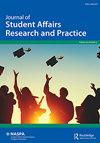The Effect of Overnutrition on Mediated Collagen in Drosophila Melanogaster Physiology
IF 0.8
Q3 EDUCATION & EDUCATIONAL RESEARCH
Journal of Student Affairs Research and Practice
Pub Date : 2023-05-31
DOI:10.47611/jsrhs.v12i2.4429
引用次数: 0
Abstract
Obesity affects approximately 13% of the adult population, resulting in excessive fat cell deposition and metabolic dysfunction. Collagen, a protein that supports skin regeneration, muscle building, and pain relief, is studied in Drosophila melanogaster under different diet conditions. This experiment aims to test whether overnutrition affects physiology and collagen due to any anatomical changes in Drosophila Melanogaster, more commonly known as fruit flies. The research conducted over several weeks utilizes two diets: an obesity-inducing diet containing excessive glucose and coconut oil and a traditional diet of blue food medium, yeast, and water. The study groups include a wild-type, collagen-mutated, and obesity-mutated group, with multiple assays measuring how the obesity-inducing diet affects each population and their collagen levels. The results reveal that the obese group experienced higher food consumption levels but had lower locomotive ability than the other test groups. Hydroxyproline, the building amino acid for collagen, and collagen levels were higher in the obesity mutant than in the wild-type and collagen mutated group. The study shows that anatomical changes in organisms are influenced by both diet and movement. The obesity group, on an obesity-inducing diet, experienced decreased movement related to increased food intake and decreased neural activity. The high-fat and high-sugar diet suppressed neuronal autophagy, created inaccurate hunger and satiety perceptions, and increased collagen deposition. Anatomical changes were observed in collagen-heavy tissue areas, whereas decreased neural activity and increased feeding rates were behavioral changes. The study emphasized the importance of a healthy diet and exercise in promoting overall health.营养过剩对黑腹果蝇介导的胶原蛋白的影响
肥胖影响了大约13%的成年人,导致过多的脂肪细胞沉积和代谢功能障碍。胶原蛋白是一种支持皮肤再生、肌肉形成和缓解疼痛的蛋白质,研究人员在不同的饮食条件下对黑腹果蝇进行了研究。本实验旨在测试营养过剩是否会由于果蝇的解剖学变化而影响生理和胶原蛋白。这项为期数周的研究采用了两种饮食:一种是含有过量葡萄糖和椰子油的肥胖饮食,另一种是含有蓝色食物培养基、酵母和水的传统饮食。研究小组包括野生型、胶原突变组和肥胖突变组,通过多次测定导致肥胖的饮食如何影响每个人群及其胶原蛋白水平。结果表明,肥胖组的食物消耗水平高于其他试验组,但运动能力低于其他试验组。肥胖突变体中胶原蛋白的构建氨基酸羟脯氨酸和胶原蛋白水平高于野生型和胶原蛋白突变组。研究表明,生物的解剖结构变化受到饮食和运动的影响。肥胖组,在肥胖诱导饮食中,经历了与食物摄入量增加和神经活动减少相关的运动减少。高脂肪和高糖饮食抑制神经元自噬,产生不准确的饥饿和饱腹感,并增加胶原蛋白沉积。在胶原蛋白重的组织区域观察到解剖变化,而神经活动的减少和摄食率的增加是行为变化。该研究强调了健康饮食和锻炼对促进整体健康的重要性。
本文章由计算机程序翻译,如有差异,请以英文原文为准。
求助全文
约1分钟内获得全文
求助全文
来源期刊

Journal of Student Affairs Research and Practice
EDUCATION & EDUCATIONAL RESEARCH-
CiteScore
2.40
自引率
9.10%
发文量
50
期刊介绍:
The vision of the Journal of Student Affairs Research and Practice (JSARP) is to publish the most rigorous, relevant, and well-respected research and practice making a difference in student affairs practice. JSARP especially encourages manuscripts that are unconventional in nature and that engage in methodological and epistemological extensions that transcend the boundaries of traditional research inquiries.
 求助内容:
求助内容: 应助结果提醒方式:
应助结果提醒方式:


